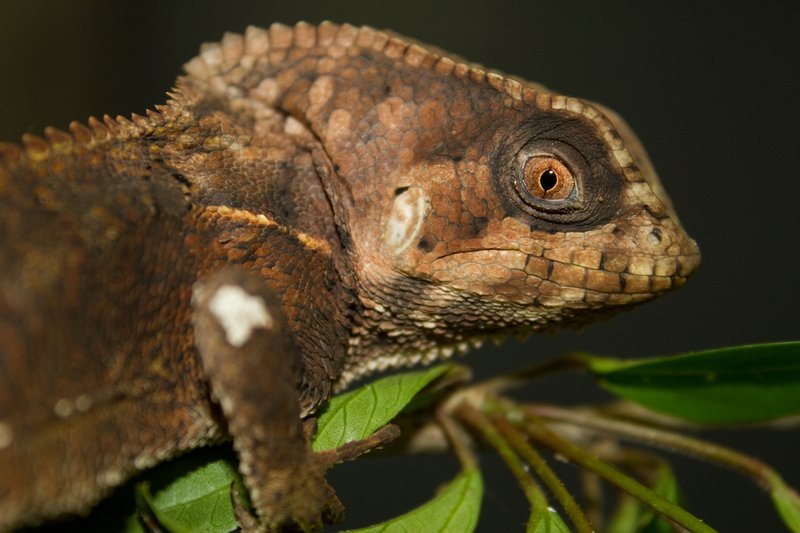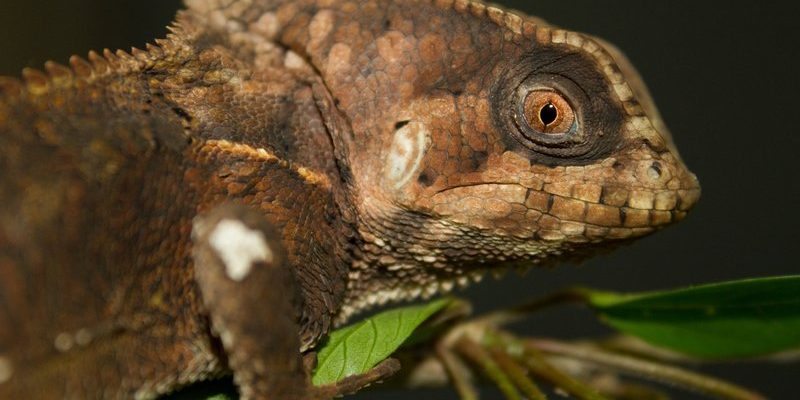
Imagine a creature adorned with a magnificent crown of bony plates, sunbathing on a warm rock in a lush tropical forest. That’s the Helmeted Iguana for you! With its unique appearance and intriguing behavior, this iguana species captures the curiosity of reptile enthusiasts and nature lovers alike. Native to the Caribbean islands, particularly the lush landscapes of the Lesser Antilles, the Helmeted Iguana is not just another pretty face; it’s a remarkable survivor in its natural habitat.
Hailing from the family Iguanidae, the Helmeted Iguana, or Ctenosaura pectinata, stands out due to its distinctive helmet-like structure on its head, which can resemble a crown. This feature isn’t just for show; it plays a crucial role in their social and mating behaviors. They are fascinating creatures that exemplify the diversity of life found on our planet. Through their vibrant colors and unique adaptations, they tell a story about evolution and the complex ecosystems that support them.
Physical Characteristics
The Helmeted Iguana is a sight to behold. Adults can grow up to about 20 to 30 inches in length. Their bodies are robust and covered in scales that can appear in various hues ranging from green and brown to darker shades, allowing them to blend into their surroundings. The helmet-like structure on their heads is made up of several bony plates that not only give them their name but also offer protection from predators.
One of the defining traits is their long, whip-like tail, which can also serve as a defense mechanism. If threatened, these iguanas have been known to whip their tails swiftly to deter attackers. Their sharp claws and powerful limbs enable them to climb trees and navigate their environment adeptly. This physical prowess makes them fascinating inhabitants of their tropical neighborhoods.
In terms of behavior, the Helmeted Iguana is primarily diurnal, meaning they are most active during the day. They bask in the sun to regulate their body temperature, often found perched on tree branches or flat rocks. Their keen eyesight helps them spot potential threats from a distance, as they have great visibility due to their height. This combination of physical features allows them to thrive in their dense forest homes.
Habitat and Distribution
The Helmeted Iguana thrives in tropical forests, specifically within the Caribbean islands. Their preferred habitats include dry forests, coastal regions, and scrublands, where vegetation is abundant. These environments provide the necessary cover and food sources like fruits, leaves, and flowers. They have adapted well to their habitats, often found basking in the sunlight of open areas or climbing trees to evade predators.
Interestingly, this species is endemic to islands such as Dominica, Saint Lucia, and Martinique. Each island offers a unique ecological niche for the iguanas to explore. The lush vegetation and tropical climate create perfect conditions for their survival. However, their limited distribution also makes them vulnerable to habitat loss due to deforestation and human encroachment.
As they navigate their surroundings, Helmeted Iguanas play a vital role in their ecosystem. They help in seed dispersal, contributing to the growth of new plants. This symbiotic relationship with the flora highlights the interconnectedness of life in these habitats. The loss of these iguanas could impact their environment in ways we are still trying to understand.
Diet and Feeding Habits
When it comes to dining, Helmeted Iguanas are primarily herbivorous. Their diet mainly consists of leaves, fruits, flowers, and occasionally insects. This makes them crucial players in their ecosystems, as they help manage plant growth and maintain balance within their habitat. The variety of plants they consume contributes to their nutritional needs, aiding in their growth and overall health.
These iguanas have strong jaws and a specialized digestive system that allows them to process tough plant materials. You might see them munching on hibiscus flowers or nibbling on the juicy leaves of local trees. This selective eating not only fuels their energy but also reflects their role as part of the food web—providing sustenance for predators such as birds of prey.
Interestingly, their feeding habits change with the seasons. During certain times of the year, they may focus on different plants that are in bloom, adapting their diet based on availability. This flexibility helps ensure their survival, showcasing their ability to thrive in ever-changing environments.
Behavior and Social Structure
Social dynamics among Helmeted Iguanas are quite fascinating. They are often spotted basking together, but they can also be territorial. Males are particularly protective of their space and can display aggressive behavior during the mating season. You might see them puffing up, waving their tails, or engaging in head-bobbing displays to establish dominance.
The communication among these iguanas is primarily visual, but they also use body language and vocalizations. You might hear them hiss or chirp when threatened or during mating displays. These interactions are crucial for maintaining their social structure and hierarchies within their groups, which can range from small family units to larger congregations.
While they are generally solitary, Helmeted Iguanas do exhibit social behaviors, especially during the breeding season. Mating rituals can include intricate displays of courtship, where males try to impress potential mates with vibrant displays. After mating, females will lay eggs in sandy nests, which adds another layer of complexity to their life cycle.
Conservation Status
Unfortunately, the Helmeted Iguana faces threats that could jeopardize its future. Due to habitat loss, invasive species, and climate change, this unique reptile is becoming increasingly vulnerable. Many areas where they once thrived have been altered or destroyed by human activity, diminishing their natural habitats.
Conservation efforts are crucial for ensuring the survival of the Helmeted Iguana. Initiatives focus on habitat restoration, creating protected areas, and raising awareness about the importance of preserving these unique reptiles. Conservationists are also working to mitigate the impact of invasive species, which can disrupt the local ecosystems and threaten native wildlife.
Local communities play an essential role in conservation efforts. By educating individuals about the Helmeted Iguana, its ecological significance, and the importance of biodiversity, we can help foster a sense of stewardship towards these magnificent creatures. The more we understand them, the better equipped we are to protect their future.
Table of Interesting Facts
| Common Name: | Helmeted Iguana |
| Scientific Name: | Ctenosaura pectinata |
| Length: | 20 to 30 inches |
| Habitat: | Tropical forests, dry forests, coastal regions |
| Diet: | Herbivorous: leaves, fruits, and flowers |
| Behavior: | Diurnal, territorial, social interactions during mating |
| Conservation Status: | Vulnerable due to habitat loss and invasive species |
FAQ
What is the lifespan of a Helmeted Iguana?
A Helmeted Iguana can live anywhere from 15 to 20 years in captivity. In the wild, their lifespan may be shorter due to predators and environmental factors. With proper care and a controlled diet, these reptiles can thrive for many years in captivity, becoming beloved pets for enthusiasts.
Are Helmeted Iguanas good pets?
Helmeted Iguanas can be great pets for those who are knowledgeable about their care. They require specific habitat conditions, such as heat and humidity, and a diet rich in plants. If you’re willing to dedicate time to their needs, they can be quite rewarding companions. However, they may not be the best choice for beginners, as they require a bit more attention than other reptiles.
How do Helmeted Iguanas reproduce?
Helmeted Iguanas reproduce sexually. Mating occurs in the spring, with males displaying elaborate courtship behaviors to attract females. Once mating happens, the female will lay eggs in sandy nests. The eggs typically hatch after a few months, and the young iguanas are independent from the moment they hatch.
What threats do Helmeted Iguanas face?
Helmeted Iguanas face several threats, including habitat destruction due to urban development, deforestation, and invasive species that compete for resources. Climate change is also affecting their habitats, leading to further challenges. Conservation efforts are crucial to safeguarding their future and ensuring stable populations.
How do Helmeted Iguanas adapt to their environment?
Helmeted Iguanas have various adaptations that allow them to thrive in their environments. Their coloration helps with camouflage, while their strong limbs and claws assist in climbing trees and navigating rocky terrains. Their herbivorous diet is also an adaptation that takes advantage of available vegetation.
Can Helmeted Iguanas swim?
Yes, Helmeted Iguanas are quite capable swimmers. They can often be seen entering the water to escape predators or to find food. Their streamlined bodies and strong limbs allow them to navigate aquatic environments, making them more versatile in their natural habitats.
Do Helmeted Iguanas exhibit social behaviors?
Yes, Helmeted Iguanas display a range of social behaviors, particularly during the mating season. They engage in territorial displays, communicate through body language and vocalizations, and sometimes bask in groups. These interactions are essential for establishing social hierarchies and mating opportunities.
How can I help Helmeted Iguanas?
You can support Helmeted Iguanas by promoting conservation efforts that protect their habitats. This can include supporting organizations that work on habitat restoration, participating in clean-up events, and raising awareness about the impact of invasive species. Every little effort counts in contributing to their survival.

